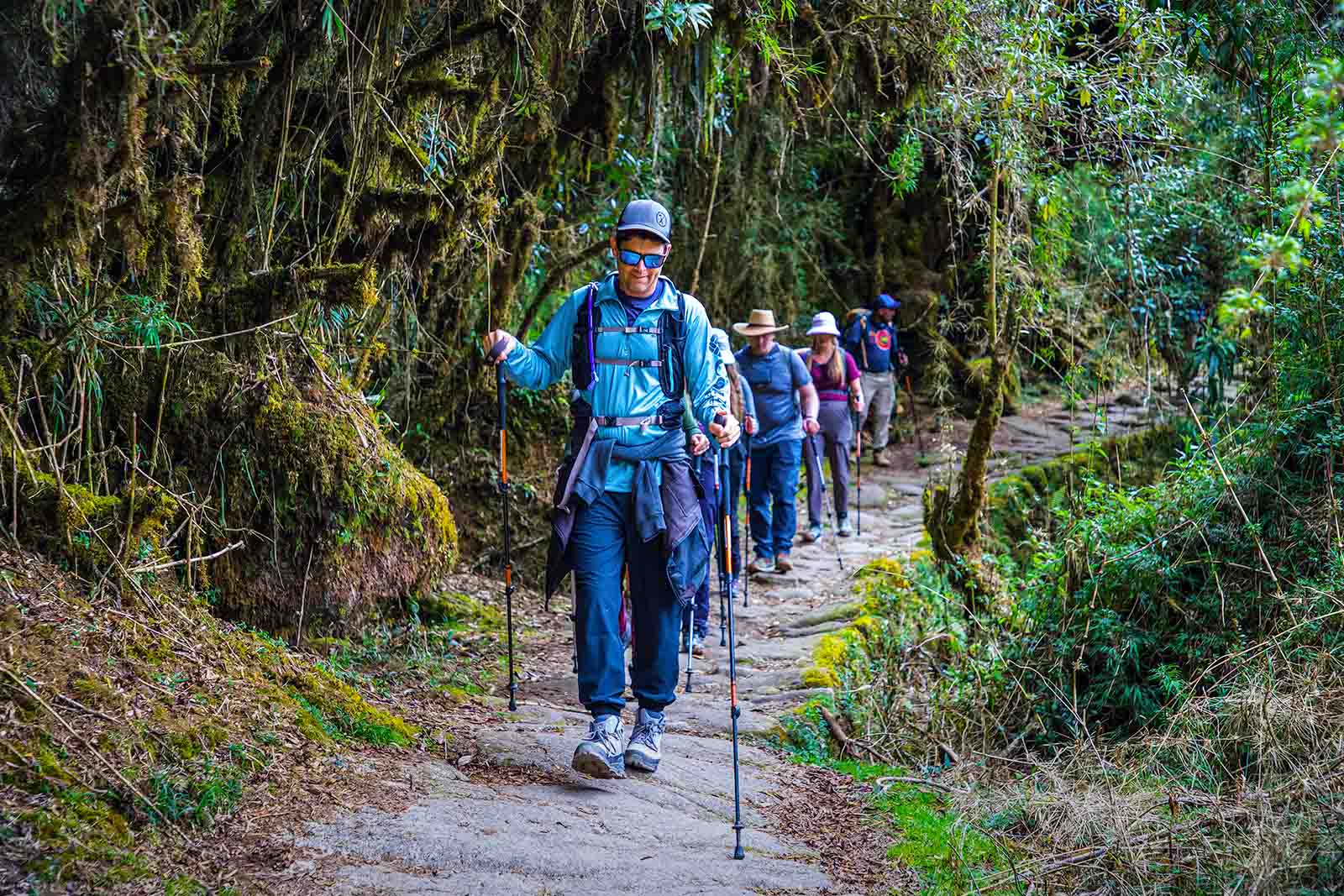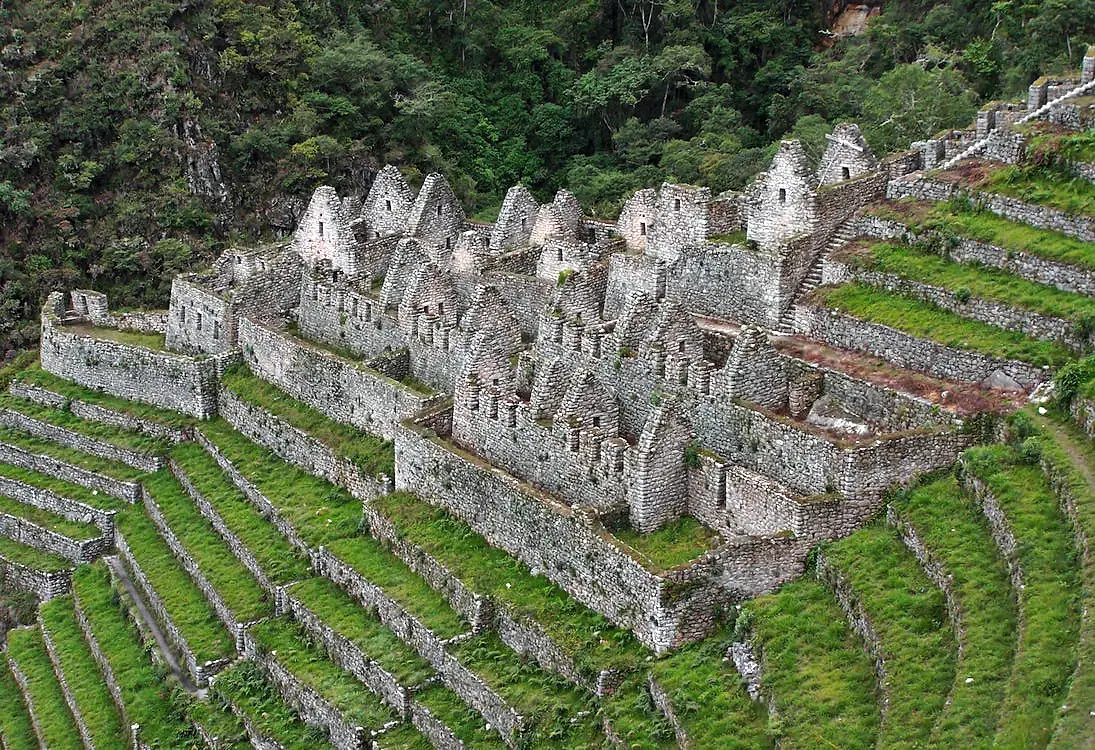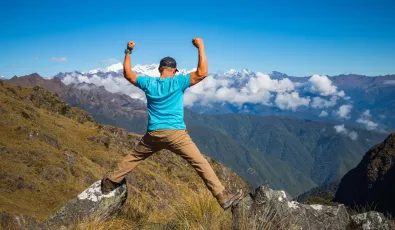The classic Inca Trail hike to Machu Picchu is one of the most popular hiking trails in the world. It is also one of the most challenging hikes in Peru. This hike has an average elevation gain of 1,000 meters (3,280 feet) and a maximum elevation of 4,215 meters (13,828 feet). Thus, hikers should book their tours far in advance, to start an adequate physical training plan and face the Inca Trail altitude.
Inca Trail Altitude
Hikers often face difficulty hiking the Inca Trail, mostly by its high points and ascends. Therefore, acclimatizing to its high-altitude treks before embarking them on is key if you are unfamiliar with the height.
How high is the Inca trail?
The Inca Trail stretches between altitudes from 1,000 meters (3,280 feet) to 4,215 meters (13,828 feet) above sea level. Its highest point, called the Dead Woman Pass, is at 4,215 meters (13,828 feet). It is almost twice Cusco's elevation!
Therefore, hikers can expect an average altitude on the Inca Trail of around 3000 meters/9,8421 feet.
We pass through this point on the Inca Trail's second day, and it can prove quite challenging.
Inca Trail Altitude Map
How long is the Inca trail?
The Inca Trail is one of the toughest hikes worldwide. Stretching 26 miles (42 km), this four-day trek in Peru's Andes Mountains covers 26 miles (42 km). Reaching altitudes up to 13,828 feet (4 215m), numerous factors make its difficulty apparent.
Inca Trail elevation points - day by day
Day 1 Inca Trail elevations
Height - Feet | Height - Meters | |
Highest Elevation (Wayllabamba camp zone) | 9,842 | 3,000 |
Inca Trail Elevation gain | 1,640 | 500 |
Total Descent of the Day | 164 | 50 |
Campsites in the Inca Trail and altitude
- Km 82, the beginning of the Inca Trail at 2718 m/8924 ft.
- Wayllambamba, the first campsite located at 3000 m / 9842 ft.
- Ayapata preferred campsite on day 1, located at 3300 m/ 10826 ft.
Archaeological sites in the Inca Trail
- Salapunku, located at 2720 mt. /8923 ft. (Visible on train, before the hike)
- Kanabamba, located at 2625 mt. /8615 ft. (Visible on train, before the hike)
- Wilkarakay, located at 2650 mt. /8694 ft.
- Patallacta, located at 2614 mt. /8576 ft.
- Wayllabamba, located at 3000 mt. / 9842 ft.
Day 2 Inca Trail elevations
Height - Feet | Height - Meters | |
Highest Elevation (Dead Women's Pass) | 13,828 | 4,215 |
Inca Trail Elevation gain | 3,610 | 1,100 |
Total Descent of the Day | 1,970 | 600 |
Campsites in the Inca Trail and altitude
- Lluluchapampa, the first rest stop on day 2, located at 3800 mt. /10829 ft.
- Pacaymayo Alto, Second campsite located at 3600 mt. /11811 ft.
- Chaquicocha, Preferred campsite on day 2, located at 3600 mt. / 11811 ft.
Mountains in the Inca Trail
- Dead Women's Pass, the highest point of the Inca Trail at 4215 mt. /13828 ft.
- Salkantay Mountain is the highest mountain in the Vilcabamba mountain range at 6,271 mt. /20,574 ft.
Archaeological sites in the Inca Trail
- Runkuracay, located at 3950 mt. /12959 ft.
Day 3 Inca Trail elevations
Height - Feet | Height - Meters | |
Highest Elevation (Runkurakay Pass) | 13,123 | 4,000 |
Inca Trail Elevation gain | 1,476 | 160 |
Total Descent of the Day | 3,280 | 1,000 |
Campsites in the Inca Trail and altitude
- Phuyupatamarca, the 3rd campsite, located at 3650 mt. /11975 ft.
- Wiñaywayna, the preferred campsite on day 3, located at 2600 mt. /8530 ft.
Mountains in the Inca Trail
- Runkurakay Pass, the second highest mountain of the Inca Trail at 4000 mt. /13123 ft.
Archaeological sites in the Inca Trail
- Sayacmarca, located at 3600 mt. / 11811 ft.
- Concharmarca, located at 3550 mt. / 11646 ft.
- Phuyupatamarca, located at 3650 mt. /11975 ft.
- Intipata, located 2840 mt. /9317ft.
- Wiñaywayna, located at 2600 mt. /8530 ft.
Day 4 Inca Trail elevations
Height - Feet | Height - Meters | |
Highest Elevation (Sun Gate or Inti Punku) | 8,858 | 2,700 |
Inca Trail Elevation gain | 1,476 | 160 |
Total Descent of the Day | 492 | 150 |
Campsites in the Inca Trail and altitude
- Puente Ruinas, the last campsite in the 5-day tours, located at 2000 mt. /6561 ft.
Mountains in the Inca Trail
- Pumasillo Mountain, visible from Machu Picchu, at 5,991 mt. /19,656 ft.
- Machu Picchu Mountain, the area's highest mountain in Machu Picchu, at 3082 mt. /10111 ft.
- Huayna Picchu Mountain, the most beautiful mountain, at 2693 mt. /8835 ft.
Archaeological sites in the Inca Trail
- Sun Gate or Inti Punku, located at 2700 mt. / 8858 ft.
- Ruins of Machu Picchu, located at 2430 mt. /7972 ft.
Inca Trail difficulty
The Inca Trail to Machu Picchu is known for being an epic and challenging hike, featuring steep inclines and sudden changes in altitude. It also can be quite steep, reaching 30% or steeper grades at times. At such heights, air density drops dramatically. So, some may experience shortness of breath, fatigue headaches, or nausea and vomits from being at such altitude. Therefore, trekkers should come prepared.
But don't afraid, despite its difficulty, the Classic Inca Trail hike to Machu Picchu can be enjoyed by most moderate and experienced hikers. Before beginning this trek, all necessary preparations must be made before embarking upon it.
Inca Trail altitude sickness
Altitude sickness, also known as Soroche, is a common condition that can affect travelers when they arrive in high-altitude areas too quickly, especially above 2,500 meters (8,200 feet). The symptoms of altitude sickness may include headache, nausea, dizziness, fatigue, and shortness of breath.
Acclimatizing to the Inca Trail altitude before embarking on it is key if you are unfamiliar with its height. To trekking the Inca Trail, it is essential that you come prepared. Here are some helpful hints and strategies on how to do just that.
It is also very useful:
- Be sure to pack appropriate clothing and gear.
- In some cases, coca tea or medication can help ease the symptom
Inca Trail weather
The Inca Trail runs along the Andes Mountains, known for its temperate climate. However, weather can change rapidly along it. Usually, the trail presents sunny days, while in the afternoons the temperature can quickly drop. In addition, nights may become cold.
So, you should pack appropriate clothing to cope with the weather on the Inca Trail. Check out our Inca Trail packing list
The Inca Trail Rainy Season
From December to March, Cusco has its rainy season. Daytime temperatures are about 18 °C (64 °F). Nights are cooler, around 9 °C (48 °F).
Moreover, the Inca Trail closes in February for maintenance. But it’s still possible to hike during the surrounding months with some trade-offs.
The good news? Fewer hikers on the trail mean a quieter, more peaceful experience. However, on the flip side, expect wet, muddy paths and colder conditions. So, If you're up for the adventure, don’t forget to pack rain gear and waterproof boots to stay dry and comfortable on the journey.
How much does it rain on the Inca Trail?
Inca Trail during the Dry season
The dry season on the Inca Trail runs from May to September, offering generally pleasant weather with fewer chances of rain, though showers are still possible. Daytime averages around 16 °C (61 °F), while nights can drop below 0 °C (32 °F).
It's also the busiest time of year, so Inca Trail permits must be booked well in advance. In addition, expect crowds, especially at Machu Picchu, and long waits for buses and trains in Aguas Calientes (Machu Picchu town). The pros are clearer skies and drier weather. Otherwise, the cons are freezing nights and heavy tourist traffic during the day.
Inca Trail during the shoulder seasons
Shoulder season is the optimal time for hiking the Inca Trail; April-May and September-October are considered shoulder seasons on this route. The weather tends to be milder during these months, making for more comfortable hikes. Though raindrops still fall, they should not be as heavy as during December-March (rainy season).
How to prepare yourself before Inca Trail
- Prepare your body: Go for daily walks of one to two hours near your home. If you can find areas with an incline, even better.
- Eat healthy: Eat carbohydrate-based meals and vegetables a few days before your hike. These will give you energy and lightness to tackle the Inca Trail altitude.
- Dress properly: To have a great hiking experience, buy comfortable hiking shoes, rain gear, a day pack, and other essentials soon. This will help you handle the weather and terrain of the Inca Trail.
- Book Your Spot: As one of the world's premier treks, the Inca Trail quickly fills up. If you wish to hike this magnificent trail, book early your Inca Trail permission as spots often sell out quickly.
- Learning some basic Spanish: When you travel the Inca Trail, you might meet people who only speak Spanish. So, knowing some basic phrases can make your trip more enjoyable.
What to do during the Inca Trail?
- Follow your tour guide's instructions at all times.
- Remember to pace yourself and stop often to rest if needed.
- Drink plenty of water throughout the day.
- Visit restrooms before beginning to hike.
- Avoid venturing off-route.
Inca Trail Permits 2026
The Inca Trail is not open for free access. Because it sits inside the Machu Picchu archaeological park, it follows a conservation plan and strict visitor caps to prevent its erosion. In addition, the Peruvian Ministry of Culture manages and controls entry to the route.
No one can hike the trail independently. All travelers must book their Inca Trail permits through a government authorized tour operator, which will arrange your Inca Trail entry, guide, porters, tents, and the rest of the logistics for your tour.
Our advice: secure your permits well in advance. Only 500 are issued per day, this number includes the permits for porters, chefs, and guides. In this form, only from 180 to 200 permits are reserved exclusively for travelers.
The Inca Trail 2026 season is now open for reservations, and spots are filling quickly. If you plan to walk the classic route to Machu Picchu, reserve as early as possible. Have your passport details ready to confirm your entry, and remember that permits are non-transferable—double-check your travel dates before booking.
Take note
If you’re ready for the adventure, get your Inca Trail permits 2026 now.
At Machu Picchu, you can relax and enjoy your time at one of the most iconic archaeological sites in the world. If you would like to live the best travel experience you can consult our Inca trail tour, there you will find more detailed information about everything related to the classic Inca trail, do not hesitate to comment or contact us.



















Add new comment